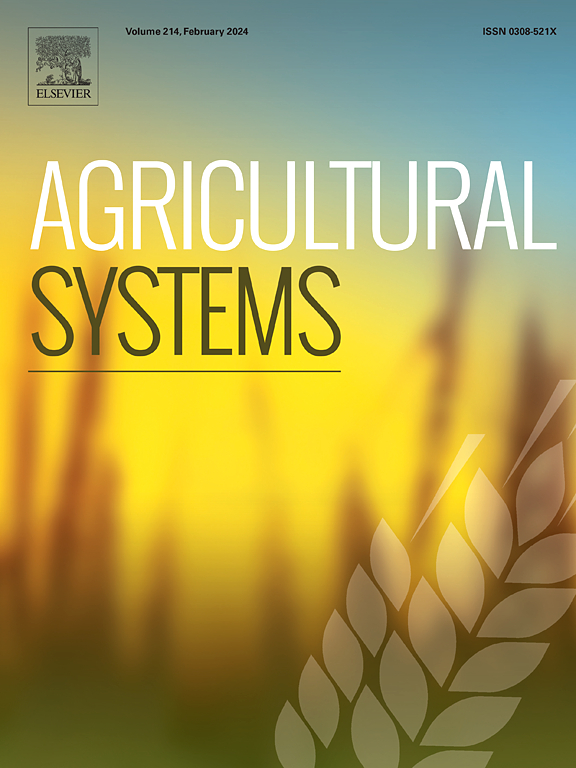在agroibis农业生态系统模拟模型中增加牧场和放牧管理
IF 6.1
1区 农林科学
Q1 AGRICULTURE, MULTIDISCIPLINARY
引用次数: 0
摘要
管理良好的牧场可为生态系统提供多种服务,但在美国中西部,越来越多的多年生牧场被改种为一年生连作作物,主要用于饲养牲畜和乙醇提炼。这种农艺集约化提高了产量,但却导致土壤流失、气候变化、水质恶化、洪水泛滥、抗微生物抗药性、杀虫剂抗药性和生物多样性减少。保持和扩大管理良好的牧场用于畜牧业生产是实现更多功能农业景观的关键,但我们需要更好地预测在替代性牧场管理下生态系统功能如何共同变化。本文章由计算机程序翻译,如有差异,请以英文原文为准。

Adding pasture and grazing management to the Agro-IBIS agroecosystem simulation model
CONTEXT
Well-managed pastures support many ecosystem services, but in the Midwest US perennial pastures increasingly are converted to annual row crops mostly fed to confined livestock and ethanol refineries. This agronomic intensification increases yields but drives soil loss, climate change, water quality degradation, flooding, anti-microbial resistance, pesticide resistance, and biodiversity decline. Maintaining and expanding well-managed pastures for livestock production is key to more multifunctional agricultural landscapes, but we need better predictions about how ecosystem functions co-vary under alternative pasture management.
OBJECTIVE
Add cool-season pasture and grazing management functionality to a process-based agroecosystem model (Agro-IBIS) and compare output to observed data in southern Wisconsin, USA.
METHODS
We adapted Agro-IBIS to represent the phenology and growth of cool-season pasture under three grazing management approaches: ungrazed, rotational (livestock moved after 2 d), and continuous. Pasture phenology, growth, and carbon (C) allocation were modified to be linked processes occurring at a daily timestep. Plant functional type (PFT) C pools (root, stem, leaf, reproductive) were updated daily through dynamic feedbacks and C-allocation that responds to phenological stage, environmental conditions, and grazing management. We compared model output to pasture observations of plant growth (aboveground biomass) and phenology (leaf area index; LAI) from a two-year field experiment in southern Wisconsin comparing grazing management approaches.
RESULTS AND CONCLUSIONS
Model output aligned well with pasture observations capturing seasonal dynamics in aboveground biomass and LAI for each grazing system (R2 = 0.47 to 0.90 across 2 response variables and all 3 grazing managements). Agro-IBIS predicted higher ANPP and NPP under rotational than continuous and no grazing, similar to experimental observations.
SIGNIFICANCE
Representation of pasture phenology, growth, and response to grazing management in Agro-IBIS improves our ability to explore how agricultural landscapes can be composed, configured, and managed for multifunctional outcomes under a changing climate.
求助全文
通过发布文献求助,成功后即可免费获取论文全文。
去求助
来源期刊

Agricultural Systems
农林科学-农业综合
CiteScore
13.30
自引率
7.60%
发文量
174
审稿时长
30 days
期刊介绍:
Agricultural Systems is an international journal that deals with interactions - among the components of agricultural systems, among hierarchical levels of agricultural systems, between agricultural and other land use systems, and between agricultural systems and their natural, social and economic environments.
The scope includes the development and application of systems analysis methodologies in the following areas:
Systems approaches in the sustainable intensification of agriculture; pathways for sustainable intensification; crop-livestock integration; farm-level resource allocation; quantification of benefits and trade-offs at farm to landscape levels; integrative, participatory and dynamic modelling approaches for qualitative and quantitative assessments of agricultural systems and decision making;
The interactions between agricultural and non-agricultural landscapes; the multiple services of agricultural systems; food security and the environment;
Global change and adaptation science; transformational adaptations as driven by changes in climate, policy, values and attitudes influencing the design of farming systems;
Development and application of farming systems design tools and methods for impact, scenario and case study analysis; managing the complexities of dynamic agricultural systems; innovation systems and multi stakeholder arrangements that support or promote change and (or) inform policy decisions.
 求助内容:
求助内容: 应助结果提醒方式:
应助结果提醒方式:


